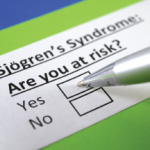ATLANTA—Dry eyes and mouth are common symptoms in the general population. When patients report these symptoms to their primary care provider and other consultants, it may prompt a referral to a rheumatologist to rule out Sjögren’s syndrome. However, as discussed in the 2019 ACR/ARP Annual Meeting session, Sjögren’s Syndrome: Beyond the Dryness, evaluation of this condition must include consideration of mimics of Sjögren’s syndrome and an understanding of its myriad manifestations, as well as various forms of Sjögren’s syndrome-associated neuropathy.
Mimics
Sara McCoy, MD, MS, an assistant professor of rheumatology and director of the Sjögren’s Syndrome Clinic at the University of Wisconsin, Madison, provided an overview. She addressed the key elements of the history and physical exam rheumatologists perform to gauge the probability of Sjögren’s syndrome. The sicca symptoms of Sjögren’s should be chronic, persistent and unrelated to other causes of dry eyes and mouth. Example: Oral candidiasis is a frequent cause of dry mouth, and it’s important to assess for signs of this condition, such as angular cheilitis and thrush. A long list of medications and smoking can also precipitate dry mouth. In this vein, Dr. McCoy noted, it’s also important to ask patients about their use of such products as topical retinoids or contact lenses, which may result in blepharitis or dry eye symptoms.
Objective measures of sicca symptoms are helpful to the clinician and tests can often be performed easily in a rheumatology office. Such objective measures include Schirmer’s test, which requires only two strips of litmus paper and 15 minutes to quantify tear production, and unstimulated salivary flow, for which a patient refrains from eating or drinking for 60–90 minutes and uses a cup to collect saliva produced over a 15-minute period, which is then measured in milliliters.
Dr. McCoy said one of the most helpful questions to ask patients with sicca symptoms is: “Have you had recurrent or persistent swelling of the salivary glands in the head or neck?” A positive response indicates the possibility of Sjögren’s syndrome. But she also shared several patient cases illustrating other conditions that cause recurrent salivary gland swelling, including hepatitis C infection, complications of HIV-like diffuse infiltrative lymphocytosis syndrome and immune reconstitution inflammatory syndrome, sarcoidosis, IgG4-related disease and eosinophilic sialodochitis.
To rule out these mimics of Sjögren’s syndrome, Dr. McCoy said rheumatologists should test for antibodies to SS-A, which are most frequently absent in these other conditions. Rheumatologists should also evaluate the histopathology of a patient’s salivary gland biopsy and search for clues indicating other conditions (e.g., hilar adenopathy in sarcoidosis, autoimmune pancreatitis in IgG4-related disease).
Neuropathy
Shamik Bhattacharyya, MD, MS, assistant professor of neurology at Brigham and Women’s Hospital, Boston, discussed the various forms of neuropathy that can arise in patients with confirmed Sjögren’s syndrome. Dr. Bhattacharyya noted that, in 25–60% of cases, neurologic symptoms precede a diagnosis of Sjögren’s syndrome by months or years.1 When they do occur, such symptoms can manifest as cranial neuropathy, ganglionopathy, axonal polyneuropathy, multiple mononeuropathy and autonomic neuropathy.
Many clinicians are familiar with the use of electromyogram and nerve conduction studies (EMG/NCS) testing to evaluate neuropathic symptoms, but this diagnostic modality doesn’t test for small-fiber neuropathies. To evaluate this form of neuropathy, a skin biopsy can provide direct visualization of nerve fibers in the dermis, and pathologic examination can quantify the nerve fiber density. It’s essential to remember the normal ranges for nerve fiber density are affected by such factors as age, gender and ethnicity. Rheumatologists must make sure these factors are accounted for by the pathologist interpreting the biopsy specimen.
When a neuropathy is identified, clinicians must consider other causes, such as diabetes or vitamin deficiencies, in the differential before assuming the neuropathy is related to Sjögren’s syndrome. This is often easier said than done, because no specific biomarker identifies a neuropathy as related to Sjögren’s. Age can also serve as a confounder because older adults are more likely than younger individuals to develop Sjögren’s syndrome and are more likely to manifest neuropathies in general.2,3
In addition to examining the clinical features of the neuropathy, it can be helpful to look at the histopathologic features of nerve biopsies and evaluate these for evidence of lymphocytic infiltration. Magnetic resonance imaging (MRI) can be elucidative, but it can also be misleading. Example: Wallerian degeneration related to a ganglionopathy can result in T2 hyperintensity of the spinal cord, which can be read as primary spinal cord disease by the radiologist.
With regard to treatment of Sjögren’s-related neuropathies, Dr. Bhattacharyya admitted there’s a paucity of large, high-quality studies proving the efficacy of various immunosuppressive regimens. Although mycophenolate mofetil and other agents have demonstrated some effectiveness in case reports and small clinical trials, Dr. Bhattacharyya has made it his practice to discuss and manage the expectations of patients early in the therapeutic encounter. Often, he has patients return six weeks after the initial consultation and, if the neuropathy is progressing, he considers a trial of a steroid pulse treatment and extended steroid taper, with the goal of slowing the neuropathy’s progression.
Although used in the treatment of inflammatory neuropathies, such as Guillain-Barre syndrome, the efficacy of intravenous immunoglobulin (IVIG) in the treatment of Sjögren’s-related neuropathy is less apparent. Dr. Bhattacharyya does not typically use this therapy.
Sjögren’s syndrome remains a challenging disease to accurately diagnose and treat. The insights provided by Dr. McCoy and Dr. Bhattacharyya will help guide clinicians. Whether one sees the future as a glass half empty or half full, one thing is clear: Sicca symptoms, with and without accompanying neuropathy, require a broad differential, and the thoughtful physician is the one best prepared to help these patients in their care.
Jason Liebowitz, MD, completed his fellowship in rheumatology at Johns Hopkins University, Baltimore, where he also earned his MD. He is currently in practice with Arthritis, Rheumatic, & Back Disease Associates, New Jersey.
References
- Fauchais AL, Magy L, Vidal E. Central and peripheral neurological complications of primary Sjögren’s syndrome. Presse Med. 2012 Sep;41(9 Pt 2):e485–e493.
- Baer AN, Walitt B. Update on Sjögren syndrome and other causes of sicca in older adults. Rheum Dis Clin North Am. 2018 Aug;44(3):419–436.
- Anish L, Nagappa M, Mahadevan A, Taly AB. Neuropathy in elderly: Lessons learnt from nerve biopsy. Age Ageing. 2015 Mar;44(2):312–317.


